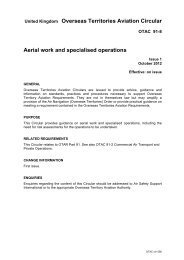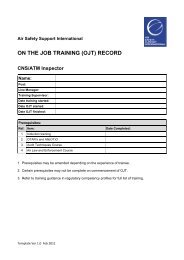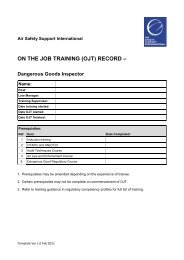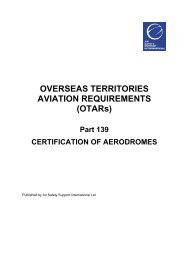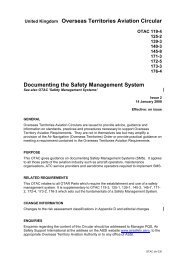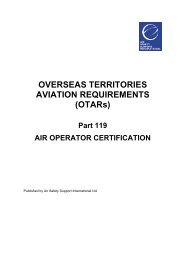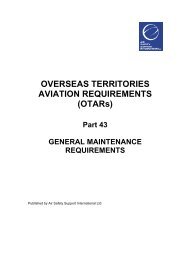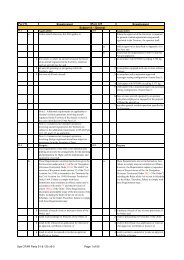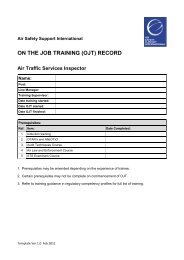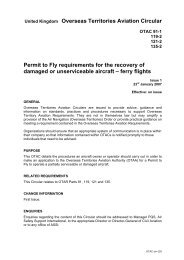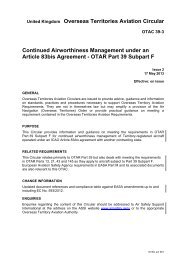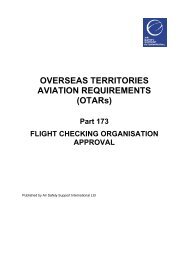Aircraft Parts - Air Safety Support International
Aircraft Parts - Air Safety Support International
Aircraft Parts - Air Safety Support International
You also want an ePaper? Increase the reach of your titles
YUMPU automatically turns print PDFs into web optimized ePapers that Google loves.
<strong><strong>Air</strong>craft</strong> <strong>Parts</strong> - OTAR Part 145.59 OTAC 145-121 IntroductionMisrepresented or unapproved scrap parts and materials that have been fitted toaircraft or included in aircraft components is a significant problem worldwide and hasbeen the cause of several incidents and accidents. This Circular provides informationand guidance on the requirements for the reporting of unapproved parts, guidelines forthe proper usage of parts removed from aircraft and guidelines for the disposal ofscrapped parts to assist in preventing their subsequent unapproved use in aircraft.2 Identification and reporting of misrepresented /unapproved partsMisrepresented/unapproved scrap parts and materials should not be received into anactive stores inventory. The following are examples of conditions to be alert for whenreceiving parts:(a) <strong>Parts</strong> showing signs of rework which were purchased as ‘new’;(b) Used parts showing signs of unapproved or inappropriate repair;(c) <strong>Parts</strong> with poor workmanship;(d) <strong>Parts</strong> with signs of rework in the area of the part data plate, part number or serialnumber;(e) Used parts lacking verifiable documentation of history and approval;(f) <strong>Parts</strong> with prices that are ‘too good to be true’;(g) Questionable part numbers, fraudulent or suspicious TSO, ETSO or FAA PMAmarkings and/or re-identification, stamp-overs or vibro-etching on the dataplate;(h) <strong>Parts</strong> delivered with photocopied or missing release certificates (ref OTAR Part 21Subpart K);(i) <strong>Parts</strong> with a finish that is inconsistent with industry standards (e.g. discolouration,inconsistencies, resurfacing);(j) <strong>Parts</strong> purchased as new but with release documentation reflecting a status otherthan new;(k) <strong>Parts</strong> with poor documentation exhibiting incomplete or inconsistent part identityinformation;(l) Intact ‘scrap’ unsalvageable parts offered in bulk weight for prices higher than formutilated parts with identical weight and content.3 Notification of misrepresented/unapproved parts3.1 Users of aircraft parts and material are reminded that suspectedmisrepresented/unapproved parts should be reported to the respective OTAA or ASSI,as applicable, through the Mandatory Occurrence Reporting Scheme as defined inOTAR Part 13.3.2 To assist in tracing misrepresented/unapproved parts and materials, persons raisingan MOR should as far as possible provide the following information on their report:(a) The name of the suspected unapproved part;(b) Part number, or any other number on the part;(c) Serial number;(d) List the next higher assembly that the suspected unapproved part is assembledinto and list the part number, if known;(e) Quantity of suspected unapproved parts found or identified;s/n 079 Issue 2 Page 3 of 6
<strong><strong>Air</strong>craft</strong> <strong>Parts</strong> - OTAR Part 145.59 OTAC 145-12(f) Principal Structural Elements removed from a high-cycle aircraft for whichconformity cannot be accomplished by complying with the mandatoryrequirements applicable to ageing aircraft.5.2 Persons disposing of scrap parts and material should, when appropriate, mutilatethose parts and materials prior to disposal. Mutilation should be such that the partsand materials become unusable for their original intended use. It should also not bepossible for them to be reworked or camouflaged to provide the appearance of beingserviceable for example by re-plating, shortening and re-threading long bolts, welding,straightening, machining, cleaning, polishing or repainting.5.3 Multilation may be accomplished by one or a combination of the following procedures,but not limited to:(a) Grinding;(b) Burning;(c) Removal of a major lug or other integral feature;(d) Permanent distortion of parts;(e) Cutting a hole with cutting torch or saw;(f) Melting;(g) Sawing into many small pieces.5.4 The following are examples of mutilation that are often less successful since they maynot be consistently effective:(a) Stamping (such as a stamped ‘R’ on the part);(b) Spraying with paint;(c) Hammer marks;(d) Identification by tag or markings;(e) Drilling small holes;(f) Sawing in two pieces since it may be possible to attempt to restore parts cut in twopieces in such a manner that the mutilation proves difficult to detect.5.5 For the disposal of scrap aircraft parts and materials for legitimate non-flight uses,such as training and education, research and development, or non-aviationapplications mutilation is not appropriate and the following methods should be used toprevent misrepresentation:(a) Permanently marking or stamping the parts, subparts and material as ‘NOTSERVICEABLE’. Ink stamping is not an acceptable method;(b) Removing original part number identification;(c) Removing the data plate;(d) Maintaining a tracking system, by serial number or other inividualised data, torecord transferred scrap aircraft parts and material, and(e) Include written instructions concerning disposition and disposal of such parts andmaterials in any agreement or contract transferring the parts and materials.s/n 079 Issue 2 Page 6 of 6




